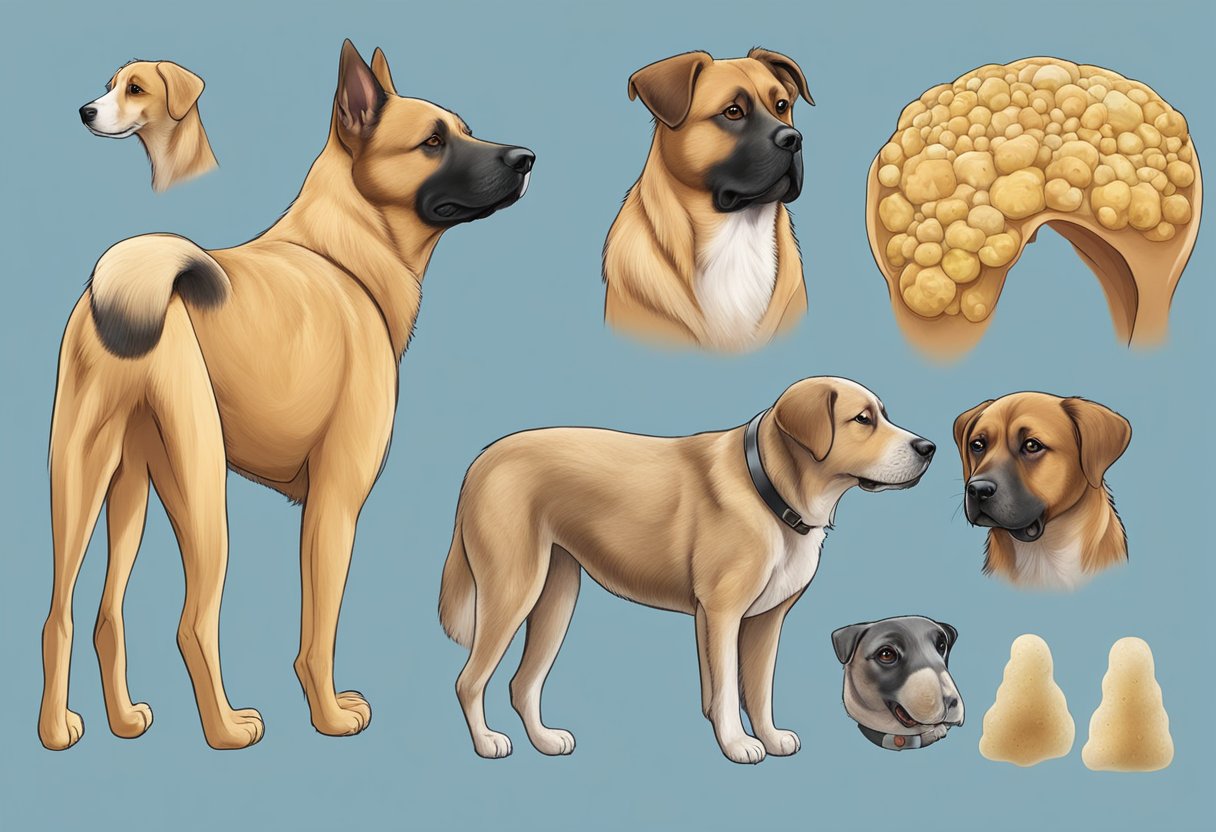Types Of Cysts on Dogs
Cysts are a common occurrence in dogs, and it is important for pet owners to be knowledgeable about the different types of cysts that can affect their furry friend. Cysts can be benign or malignant, and early detection is key to ensuring appropriate treatment. In this article, we will explore the various types of cysts that can occur in dogs, as well as their symptoms, diagnosis, and treatment options.
Common Types of Cysts in Dogs
There are several types of cysts that can develop in dogs, including sebaceous cysts, follicular cysts, dermoid cysts, and true cysts. Sebaceous cysts are the most common type of cyst and are typically benign. They develop in the sebaceous glands and can appear as small, raised bumps on the skin. Follicular cysts develop in the hair follicles and can be caused by a variety of factors, including hormonal imbalances and allergies. Dermoid cysts are rare and are typically congenital, meaning they are present at birth. True cysts are less common and can develop in various parts of the body.
Differentiating Benign and Malignant Growths
Not all cysts are benign, and it is important to differentiate between benign and malignant growths. Benign cysts are typically slow-growing and do not spread to other parts of the body. Malignant cysts, on the other hand, can grow rapidly and can spread to other parts of the body, making early detection and appropriate treatment crucial. Veterinarians can perform various tests to determine whether a cyst is benign or malignant, including a biopsy, ultrasound, or X-ray.
Key Takeaways
- There are several types of cysts that can develop in dogs, including sebaceous cysts, follicular cysts, dermoid cysts, and true cysts.
- Early detection is key to ensuring appropriate treatment for cysts in dogs.
- Veterinarians can perform various tests to determine whether a cyst is benign or malignant.
Common Types of Cysts in Dogs

Cysts are fluid-filled sacs that can develop under the skin or within the body of a dog. They can be caused by various factors such as allergies, infections, trauma, or genetic predisposition. Here are some of the most common types of cysts in dogs:
Sebaceous Cysts
Sebaceous cysts are the most common type of cysts in dogs. They develop from the sebaceous glands, which are responsible for producing sebum, an oily substance that lubricates the skin and hair follicles. Sebaceous cysts can vary in size and shape and are usually located on the trunk, neck, or head of a dog. They are typically benign and do not require treatment unless they become infected or cause discomfort to the dog.
Follicular Cysts
Follicular cysts are another type of cyst that can develop in dogs. They occur when hair follicles become blocked, leading to the accumulation of fluid and the formation of a cyst. Certain breeds such as terriers and hairless breeds are more prone to developing follicular cysts. Follicular cysts can be treated through surgical removal or by draining the fluid.
Dermoid Cysts
Dermoid cysts are rare in dogs but can occur in any breed. They are formed from embryonic cells that have the ability to produce skin, hair, and teeth. Dermoid cysts can be located anywhere on the dog’s body and can vary in size. They are usually benign but can become infected or cause discomfort to the dog.
Interdigital Cysts
Interdigital cysts, also known as interdigital furuncles, are cysts that develop between the toes of a dog. They are usually caused by a bacterial infection that enters the skin through a cut or scratch. Interdigital cysts can be painful and can cause limping or reluctance to walk. Treatment may involve antibiotics, draining the cyst, or surgical removal.
True Cysts
True cysts are lumps containing accumulated fluid secreted by cells within their lining. They can occur anywhere on the dog’s body and can vary in size depending on how long they are present. True cysts are usually soft due to the accumulated fluid and are not harmful to dogs but can be bothersome depending on their location and size.
In conclusion, cysts can be common in dogs and can be caused by various factors. It is important to monitor any lumps or bumps on your dog and seek veterinary attention if they become infected or cause discomfort. Treatment options may include surgical removal, draining the fluid, or antibiotics.
Differentiating Benign and Malignant Growths
When it comes to lumps and bumps on dogs, it’s important to differentiate between benign and malignant growths. Benign lumps are non-cancerous and typically don’t spread to other parts of the body, while malignant tumors are cancerous and can spread to other organs and tissues.
Lipomas and Fatty Tumors
Lipomas are the most common type of benign lump found on dogs. They are soft, movable, and typically slow-growing. Lipomas are made up of fat cells and are usually found just beneath the skin. They are more common in older dogs and can grow quite large, but they are generally not a cause for concern unless they are interfering with the dog’s movement or quality of life. In most cases, lipomas can be left alone, but if they are causing problems, they can be surgically removed.
Mast Cell Tumors
Mast cell tumors are one of the most common types of malignant tumors found on dogs. They can appear as a raised bump or lump on the skin and can vary in size and appearance. Some mast cell tumors can be very aggressive, while others are less so. Early detection and treatment are crucial for a good prognosis. Treatment options include surgical removal, radiation therapy, and chemotherapy.
Melanomas
Melanomas are tumors that arise from pigment-producing cells called melanocytes. They can be benign or malignant and can appear anywhere on the body, including the skin, eyes, and mouth. Melanomas that occur in the mouth or on the toes are more likely to be malignant. Treatment options include surgical removal, radiation therapy, and chemotherapy.
Squamous Cell Carcinomas
Squamous cell carcinomas are a type of skin cancer that can occur on any part of the body, but are most commonly found on the ears, nose, and mouth. They can appear as a raised, scaly bump or ulcerated lesion. Squamous cell carcinomas can be aggressive and can spread to other parts of the body if left untreated. Treatment options include surgical removal, radiation therapy, and chemotherapy.
In order to determine whether a lump or bump is benign or malignant, a veterinarian may recommend a biopsy. This involves taking a small sample of the tissue and examining it under a microscope. A biopsy can help determine the type of tumor and the best course of treatment.
Symptoms and Diagnosis of Cysts
Cysts are fluid-filled sacs that can develop anywhere on a dog’s body. They can be benign or malignant and may cause discomfort or pain. The following are some of the symptoms of cysts in dogs:
Physical Examination
During a physical examination, a veterinarian may be able to feel a cyst on a dog’s body. They may also notice other symptoms, such as discharge or swelling. If a cyst is located in a pressure point, it may cause discomfort or pain when touched.
Biopsy and Cytology
If a veterinarian suspects that a lump or bump on a dog’s body is a cyst, they may perform a biopsy. A biopsy involves removing a small sample of the cyst and sending it to a laboratory for analysis. Cytology, which involves examining cells under a microscope, may also be used to diagnose cysts.
Imaging Techniques
Imaging techniques such as X-rays, ultrasounds, and MRIs may be used to diagnose cysts in dogs. These techniques can help determine the size, location, and type of cyst. They may also be used to monitor the growth of a cyst over time.
If a dog has a cyst, it is important to have it diagnosed and treated by a veterinarian. While some cysts may be benign and not require treatment, others may be malignant and require surgery or other treatments.
Treatment Options for Cysts and Tumors
There are various treatment options available for cysts and tumors in dogs. The treatment option that is chosen will depend on the type of cyst or tumor, its size, and whether it is benign or malignant. Here are some of the most common treatment options:
Surgical Removal
Surgical removal is the most common treatment option for cysts and tumors in dogs. This involves removing the cyst or tumor and any surrounding tissue that may be affected. In some cases, the entire affected organ may need to be removed. This is usually the case for malignant tumors.
Medication and Antibiotics
In some cases, medication and antibiotics may be prescribed to help treat cysts. Antibiotics are typically used to help prevent infection, while medication may be used to help reduce inflammation or pain associated with the cyst. However, medication and antibiotics are not always effective in treating cysts and tumors.
Chemotherapy and Radiation Therapy
Chemotherapy and radiation therapy are typically used to treat malignant tumors in dogs. These treatments work by killing cancer cells and preventing them from spreading to other parts of the body. However, these treatments can also have side effects, including nausea, vomiting, and hair loss.
Overall, the best treatment option for cysts and tumors in dogs will depend on the type of cyst or tumor, its size, and whether it is benign or malignant. It is important to consult with a veterinarian to determine the best course of action for your dog.
Prevention and Care for Dogs with Cysts
Cysts are a common occurrence in dogs and can be managed with proper care and prevention. Here are some ways to prevent and care for dogs with cysts:
Regular Veterinary Check-Ups
Regular veterinary check-ups are essential in the early detection of cysts in dogs. A veterinarian can detect the presence of cysts during a physical examination and recommend necessary treatment. It is essential to schedule regular check-ups for puppies as well, as cysts can develop at any age.
Genetics and Breeding
Genetics plays a significant role in the development of cysts in dogs. Some breeds are more prone to cysts than others. It is essential to research the breed of dog before breeding to ensure that the puppies do not inherit any genetic predispositions to cysts. Responsible breeding practices can significantly reduce the incidence of cysts in dogs.
Pet Health Insurance
Pet health insurance can help cover the cost of treatment for cysts in dogs. It is essential to research and choose a pet health insurance plan that covers cyst treatment. This can help alleviate the financial burden of treatment and ensure that the dog receives proper care.
In addition to these prevention and care methods, it is also essential to maintain the dog’s skin health. Regular grooming and cleaning can help prevent skin irritation and inflammation, which can lead to the development of cysts. If a cyst is detected, it is essential to follow the veterinarian’s recommended treatment plan for the best outcome.
Overall, with proper care and prevention, cysts in dogs can be managed effectively. Regular veterinary check-ups, responsible breeding practices, and pet health insurance can help prevent and treat cysts, ensuring the dog’s health and well-being.






